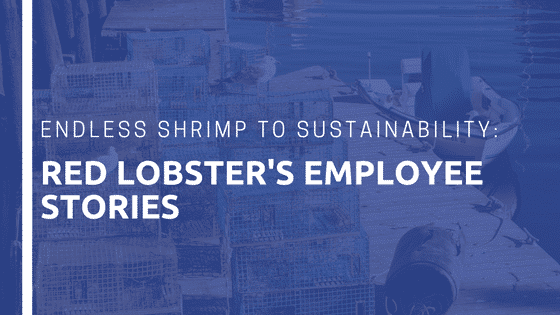From Endless Shrimp to Sustainability: Red Lobster’s Use of Employee Stories
My name is Kat, I’m the inbound marketing manager here, I’m 26 years old, and as of January of 2018 I had never once stepped foot in a Red Lobster restaurant. That is, until our very own Lauryn Sargent dragged me into one on our very first business trip together in San Francisco to taste those cheddar biscuits for myself.
Growing up along the beach in New Jersey, we had access to fresh local fish whenever we wanted, making a restaurant like Red Lobster feel like a big ol’ conglomerate that wasn’t worth our time when we could support local businesses with REAL fish.
And while the cheddar biscuits and my shrimp scampi were pretty great, I still wasn’t convinced that Red Lobster was the place for this Jersey Girl….until I turned on the TV one night recently and saw a version of this ad below.
Employee Stories
It turns out, there’s a lot more to the chain of restaurants than endless shrimp…there’s sustainability, and real life lobstermen and women finding ways to keep the restaurants stocked up while supporting their family business and protecting the environment. I was floored. Suddenly I felt better about Red Lobster as a whole…and I’m just a consumer, not a potential employee.
While it’s unclear if Red Lobster’s reputation was recently in trouble or if this was a really smart employer branding move on their part to shift the conversation about them towards sustainability, they sure won me over.
Investing in employer branding goes beyond being appealing to potential employees, but also to creating a public image that’s appealing as well. Whatever the purpose, employee stories are one of the best means to an end…especially if your end is doing it like Red Lobster and reeling people into your brand and everything it stands for.
Show don’t Tell
As we say to clients all the time when we prep them to interview and film with us, show don’t tell. It’s one thing to say you support and encourage ethical and sustainable fishing and sourcing methods, but it’s another thing altogether to tell a story about how you’re doing so. In the case of Red Lobster, they did just that, even making it all the more powerful by having it come directly from one of their employees rather than a talking head or executive.
Stories (employee stories specifically) remain one of the most powerful tools in an employer branding professional’s tool belt, and yet they’re so often underutilized. There’s actually scientific and psychologic backing as to why stories and storytelling resonates better with people, especially when it comes to advertisements and marketing. And as much as you don’t want to admit it, employer branding is it’s own special form of marketing.
Using stories to shift a brand’s story and reputation is one of the easiest and quite frankly, believable ways to enact a change in how a company may be perceived by both employees and customers alike. But shifting the conversation around a brand isn’t the only reason why you should be utilizing employee stories.
Even the most reputable and recognizable brands out there can benefit from implementing employee stories in their strategy. According to a Glassdoor survey, about 67% of employees believe that retention rates within companies would be higher if candidates simply knew more about what it was like to work at the company before they took the job.
Find the stories
And according to LinkedIn, candidates are 3x more likely to trust the company employees over the company to provide credible information on what it’s actually like to work there. This begs the question, what are you waiting for?
Red Lobster proves to us that your stories are there, just waiting for you to show them off, it’s simply a matter of asking the right questions and taking the time to dig into what’s important to your employees.

